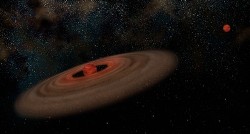Apr 8 2010
A mysterious planet-like object orbiting a not-quite-starlike "brown dwarf" is the most recent enigma discovered by astronomers with their ever-more powerful telescopes. Kamen Todorov, a graduate student at Penn State University, and a team of co-investigators including Kevin Luhman, assistant professor of astronomy and astrophysics at Penn State, used the keen eyesight of the Hubble Space Telescope and the Gemini observatory to directly image the planet-like object. The team's discovery, which resulted from a survey of 32 brown dwarfs in the Taurus star-forming region, will be published in the Astrophysical Journal.
 This is an artist's conception of the binary system described in this story showing the primary brown dwarf (at left) and its orbiting planet-like object (at right).
This is an artist's conception of the binary system described in this story showing the primary brown dwarf (at left) and its orbiting planet-like object (at right).
The astronomers estimate that the smaller orbiting object is five to 10 times the mass of Jupiter and that it orbits at roughly the distance from the Sun to Saturn or Uranus -- which makes it planet-like -- but it formed only 1 million years ago -- which is much faster than the time some theories predict is needed to build a planet. Their investigations of the nature of this mysterious object and its companion brown dwarf have revealed a new mechanism that Nature can use to make orbiting planetary-mass objects. "Our research demonstrates that nature can make planetary-mass bodies through the same mechanism that builds stars -- and that the mystery object has both planet-like and star-like characteristics," said Luhman, who is a researcher at the Penn State Center for Exoplanets and Habitable Worlds.
But what is the true nature of this object? Is it really a planet? To answer this question, the scientists considered the three possible ways such an object could form: 1) dust in a circumstellar disk slowly merges to form a rocky planet 10 times larger than the Earth, which then accumulates a large gaseous envelope; 2) a lump of gas in a circumstellar disk quickly collapses to form an object the size of a gas-giant planet; or 3) rather than forming from the dust in a circumstellar disk, a companion forms from the collapse of the vast cloud of gas and dust in the same way as a star or a brown dwarf forms.
"The third scenario is the likely solution because this star-like object is too young to have formed by the first scenario, which is very slow," Luhman said. Although the second mechanism does occur rapidly, the disk around this central brown dwarf probably did not contain enough material to make an object this large in mass.
"The most interesting implication of this result is that it shows that the process that makes binary stars extends all the way down to planetary masses -- so it appears that nature is able to make planetary-mass companions through two very different mechanisms."
If the mystery companion formed through cloud collapse and fragmentation, as stellar binary systems do, then it is not a planet by definition because planets build up inside disks. Further supporting evidence comes from the presence of a nearby binary system that contains a small red star and a brown dwarf. Brown dwarfs are objects that typically are 10s of times the mass of Jupiter and are too small to sustain nuclear fusion to shine as stars do. Luhman thinks that all four objects may have formed in the same cloud collapse, making this in actuality a quadruple system. "The configuration closely resembles quadruple star systems, suggesting that all of its components formed like stars," said Luhman.